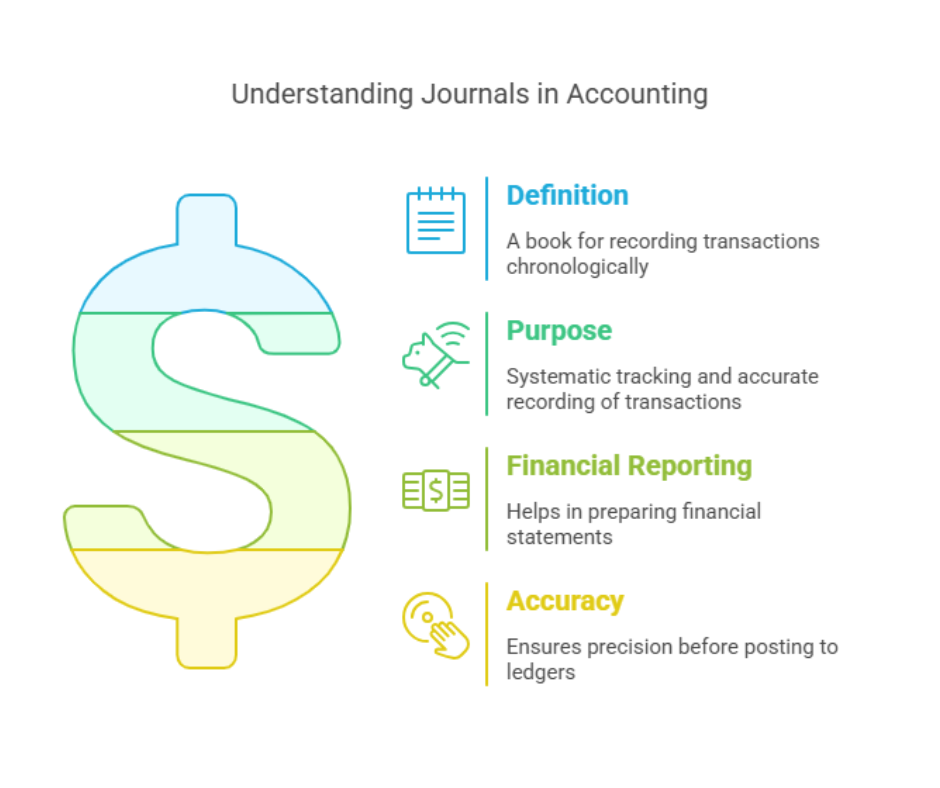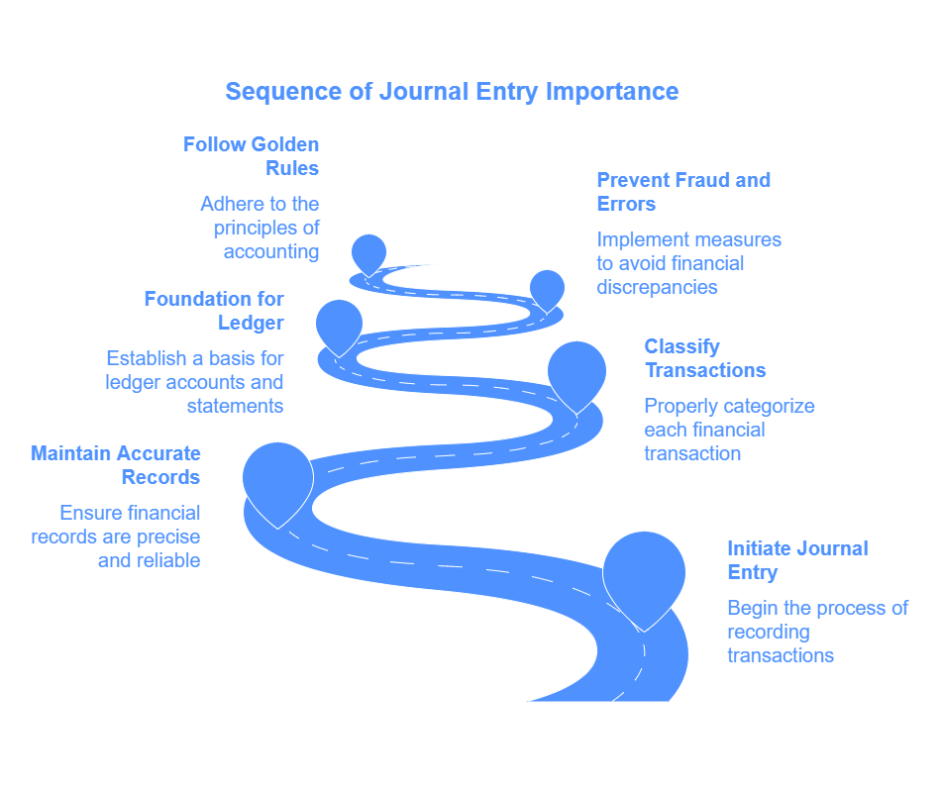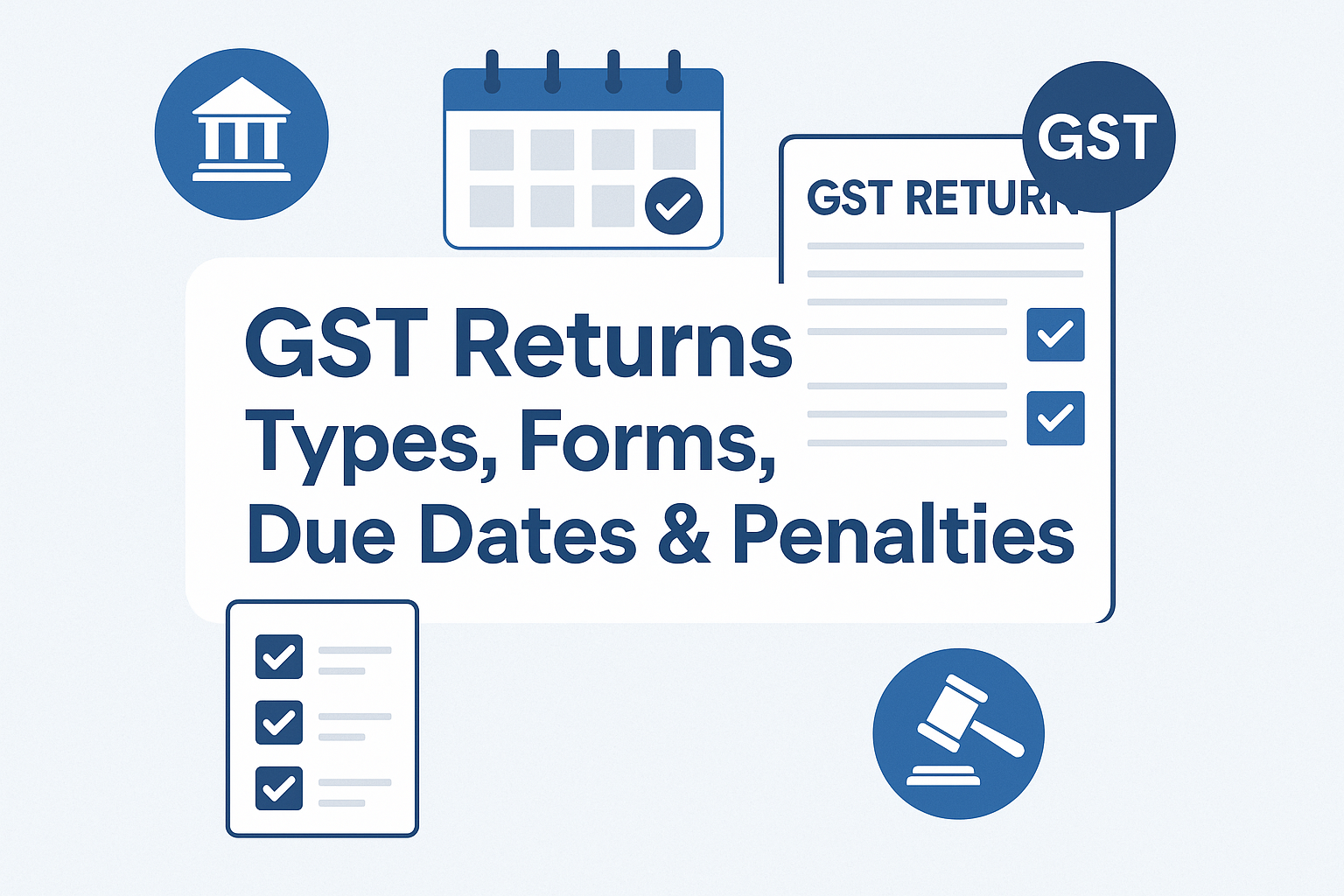Today, let’s break down how financial transactions are recorded using journal entries the
first step in the accounting cycle!
What is a Journal?
1. Definition
A journal is a book of original entry where financial transactions are recorded in
chronological order using the double-entry system.
2. Purpose of a Journal
✅ Keeps a systematic record of financial transactions 📋
✅ Helps track business activities for financial reporting 📊
✅ Ensures transactions are recorded accurately before posting to ledgers 🏦
What is a Journal Entry?
A journal entry is a record of a financial transaction that follows the debit-credit rules in the
double-entry system.
Each journal entry includes:
- Date 📅 – When the transaction occurred.
- Account Titles 📂 – The accounts affected.
- Debit & Credit Amounts 💵 – The transaction values.
- Narration 🗣 – A brief explanation of the transaction.

Golden Rules of Accounting
Rules for Journal Entries:
(i) Personal Account Rule
✔ Debit the Receiver 🧾
✔ Credit the Giver 💰
Example:
- Paid ₹2️5,000 to a supplier
- 📉 Supplier A/c Dr. ₹2️5,000
- 💰 Cash A/c Cr. ₹2️5,000
(ii) Real Account Rule
✔ Debit what comes in 📥
✔ Credit what goes out 📤
Example:
- Purchased machinery for ₹2️50,000
- 🏭 Machinery A/c Dr. ₹2️50,000
- 💵 Cash A/c Cr. ₹2️50,000
(iii) Nominal Account Rule
✔ Debit all expenses & losses 📉
✔ Credit all incomes & gains 📈
Example:
- Paid salary of ₹1️0,000
- 💼 Salary Expense A/c Dr. ₹1️0,000
- 💰 Cash A/c Cr. ₹1️0,000
Common Transactions & Their Journal Entries
(A) Capital & Loan Transactions
1. Owner Invests Capital (₹2️1️,00,000 in Cash):
💰 Cash A/c Dr. ₹2️1️,00,000
📈 Capital A/c Cr. ₹2️1️,00,000
2.Business Takes a Loan (₹2️50,000 from Bank):
💰 Cash A/c Dr. ₹2️50,000
🏦 Loan Payable A/c Cr. ₹2️50,000
(B) Asset Purchases
️1. Purchased Furniture for ₹2️0,000 (Paid in Cash):
🧾 Furniture A/c Dr. ₹2️0,000
💵 Cash A/c Cr. ₹2️0,000
2. Purchased Machinery for ₹1️,00,000 on Credit from XYZ Ltd.:
🏭 Machinery A/c Dr. ₹1️,00,000
🏢 XYZ Ltd. A/c Cr. ₹1️,00,000
(C) Sales & Revenue
1. Sold Goods for ₹2️2️5,000 in Cash:
💰 Cash A/c Dr. ₹2️2️5,000
🏬 Sales A/c Cr. ₹2️2️5,000
2. Sold Goods for ₹40,000 on Credit to ABC Ltd.:
🏢 ABC Ltd. A/c Dr. ₹40,000
🏬 Sales A/c Cr. ₹40,000
(D) Expenses & Payments
1. Paid Rent ₹2️5,000:
🏠 Rent Expense A/c Dr. ₹2️5,000
💰 Cash A/c Cr. ₹2️5,000
2. Paid Electricity Bill ₹2️1️,500:
⚡ Electricity Expense A/c Dr. ₹2️1️,500
💵 Cash A/c Cr. ₹2️1️,500
(E) Receipts & Collections
1. Received ₹2️30,000 from ABC Ltd. for Previous Credit Sale:
💰 Cash A/c Dr. ₹2️30,000
🏢 ABC Ltd. A/c Cr. ₹2️30,000
2. Received Interest Income ₹2️3,000:
💰 Cash A/c Dr. ₹2️3,000
📈 Interest Income A/c Cr. ₹2️3,000
Steps to Record Journal Entries
Step 1️: Identify the transaction. 🔍
Step 2️: Determine the accounts involved. 📝
Step 3: Apply the Golden Rules of Accounting. 🔢
Step 4: Decide which account to debit and credit. 💰
Step 5: Record the entry in the journal with a narration. ✍

Importance of Journal Entries & Key Takeaways
Importance of Journal Entries
✔ Helps maintain accurate financial records 📋
✔ Ensures every transaction is properly classified 📊
✔ Forms the foundation for ledger accounts & financial statements 📖
✔ Prevents fraud & errors through systematic recording 🔍
Key Takeaways
✔ Journal Entries are the first step in recording financial transactions. 📜
✔ Every transaction follows the Golden Rules of Accounting. 📖
✔ Debits & Credits ensure books remain balanced. ⚖️
✔ Common transactions involve capital, purchases, sales, and expenses. 💰




